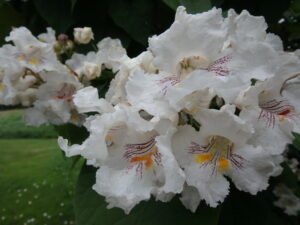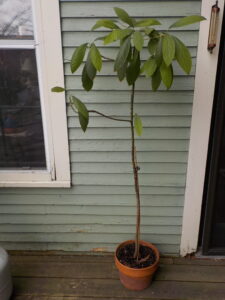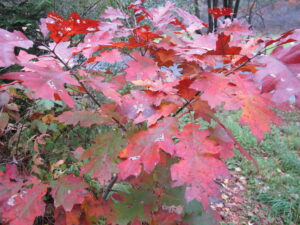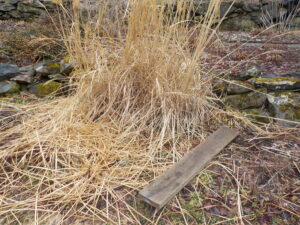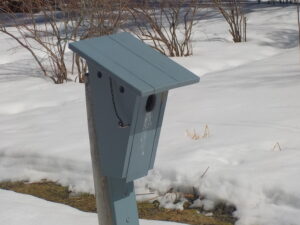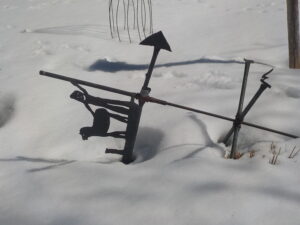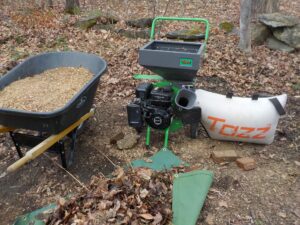No Mow May
Posted on Tuesday, April 25, 2023 · Leave a Comment
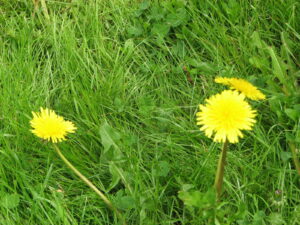
Dandelions in lawn help feed pollinators early in the spring
In 2019 a British non-profit called Plantlife coined the phrase “No Mow May”. They proposed that gardeners leave their mowers in storage for the month of May in order to let wildflowers and weeds bloom and provide pollen and nectar for pollinators. And of course the caterpillars of many pollinators feed all our baby birds, so the ramifications are vast.
Early spring is a tough time for pollinators, especially here in New England as there are not many flowers to visit. I like the idea of a simple action that can have positive effects on so many species of wildlife.
The most obvious advantage to you is that you have a few extra hours to do other things in your garden. May is a busy time for most of us: raking out beds, pulling weeds that wintered over and are starting to grow in our beds. Planting early vegetables and flowers. Shopping for new plants. We can even bask in the sun like seals if we have the time to do so.
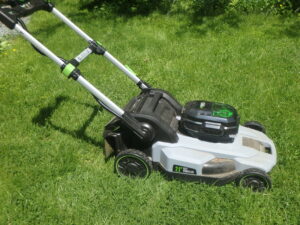
Electric mowers have improved greatly in the past few years. They are quiet and non-polluting
Next, you are not spending any money on gas or electricity (if you have a battery-powered mower). Most gas powered mowers do not have the emission controls that are required for cars. According to the Environmental Protection Agency (EPA), one hour operating a new gasoline lawn mower emits the same amount of volatile organic compounds and nitrogen oxide as driving a new car 45 miles.
According to the EPA, lawn mowers and other garden machines like leaf blowers, string trimmers, etc., contribute as much pollution as our cars and homes. The statistics on lawns are deceiving; two percent of the land mass in America is lawn. But that is more square miles of land than all the corn grown here. Roughly 80% of homes have at least some lawn.
If we mow our lawns from May to the end of October, that’s six months of mowing. Eliminating one month of mowing reduces those emissions by 17%. Good for the environment, good for the wallet.
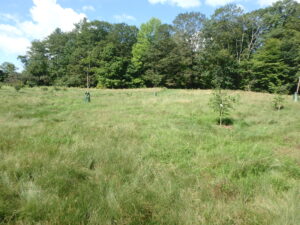
We stopped mowing this lawn and here it is in late August
For the last two years I have been installing trees in what was a 5-acre lawn in Hanover, NH. So far we have planted about 150 of them – and we largely stopped the mowing, just leaving pathways throughout. The owners now have their field mowed everywhere just once every two years to control growth of unwanted woody plants like poplars, which spread by root.
We were delighted last spring to see the field come alive in spring. At least a dozen species of flowers bloomed, probably more. And the bees and other pollinators just loved it.
You must be wondering what happened when we just stopped mowing. Grass grew, and largely flopped over as it got taller. It was nothing like the unruly 2- or 3-foot tall mess that the mowing guys predicted. We were always able to walk anywhere in the field even though it was not mowed. Of course, when the mowing crew shows up soon, they have big, industrial-scale mowers that will chew up anything.
For your home lawn you may want to pay attention to how tall the grass gets in May. Presumably your push mower or electric mower will not mow tall grasses as easily as the riding mowers used on the field described above. If you can only avoid mowing for two or three weeks, it’s still better than mowing it short every week in May.
Another advantage to the No Mow May is that you will probably end up with a better, more resilient lawn in times of drought. The longer your grass, the more food it produces for the roots, allowing them to grow longer and deeper.
Your lawn might complain about being mowed short on June 1. So put the blades up as high as they go, to avoid giving the lawn that “scalped” look. The lower parts of blades of grass may be a little pale in color as they were shaded out by the taller parts. Leave your lawn a little longer this year – it doesn’t have to look like the infield of Fenway Park.
What about bare spots on the lawn? These are often filled in with crabgrass, an annual weed. For large areas, you will need to plant new lawn seed – the sooner the better.
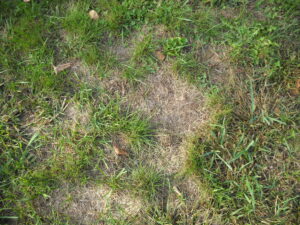
This part of the lawn needs re-seeding
Filling in empty spots can be done in May by scratching the soil with a short-tined rake to loosen the surface. Add half an inch of compost and mix it in with the soil. Then spread seed over it – just broadcast it with your hand in small areas. I use a lawn/leaf rake to mix the seed in with the soil: I flip over the rake and drag it lightly over the area, which mixes in the seed well. If you have a metal tamper, use it to press down the planted area. If not, use a small board and step on it.
I never fertilize my lawn, and it looks fine to me. If your lawn is a little feeble, check the soil pH. If it is too acidic, you can spread some limestone. Lawn grass prefers nearly neutral pH.
So take a break from mowing this May. Tell your neighbors what’s going on, so they won’t call you a lazy slug! You are just being environmentally conscious. Thanks!
Henry is an organic
gardener who has lived in the same house since he bought it in 1970. He is the author of 4
gardening books. Reach him at
henry.homeyer@comcast.net.
Early Spring Bloomers
Posted on Tuesday, April 18, 2023 · Leave a Comment
I like to have blossoms in the garden and in vases everywhere. I try to have something blooming all the time – or as often as possible. Right now, in mid-April, I count more than ten species of plants in bloom, along with seven species of bulb plants which are blooming by the hundred for me.
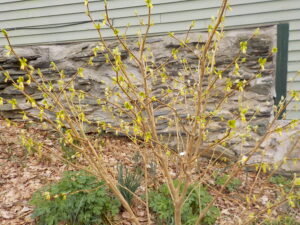
Leatherwood
Let’s start with trees and shrubs – what I call woodies. The most unusual woody is leatherwood (Dirca palustris). This is a native woodland plant that does well in part shade. Although the literature says it prefers moist, rich soil, I have it in dry soil and it does well there.
Leatherwood has small greenish-yellow flowers that appear about the same time as forsythia –mid April for me. Mine is slow growing with lovely gray bark that reminds me of beeches. This is a well-mannered, slow growing plant that stays 3- to 6-feet tall and wide.
February Daphne (Daphne mezereum) is in bloom now with highly fragrant pinky-purple flowers. It is originally from Europe, Turkey and Iran. I love it so much I named a corgi after it (she is now gone, alas). It stays 3-5-feet tall and wide. In the fall it has produces small red berries.
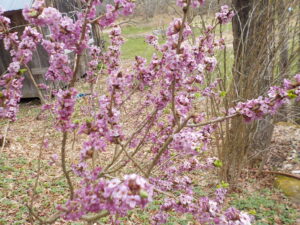
I named a dog after this shrub, Daphne mezereum or February daphne
Magnolias are in bloom now, too. My favorite is the Merrill magnolia, a hybrid which produces double white, lightly fragrant flowers. I planted mine as a small tree in 2004, and now, 19 years later, it is about 40 feet tall with a spread of 25 feet. It blooms reliably (nine years out of ten) on my birthday, April 23. It is a good specimen tree to put in a lawn, and will do well even if the soil is consistently moist to soggy.
These magnolias come as both single-stem and multi-stem trees, but most are multi-stemmed, as mine is. However, when the stems get big they grow together at their base. Sometimes the included bark rots and weakens the stems, making them susceptible to splitting. I removed one big stem on mine two years ago and the tree has recovered.
Forsythias are in bloom everywhere with bright yellow flowers. If yours only blooms down low, in the area covered by snow, the buds which were formed last summer were killed by the winter cold. So get rid of it and buy a new variety such as New Hampshire Gold, Vermont Gold or Meadowlark. All are hardy throughout New England.
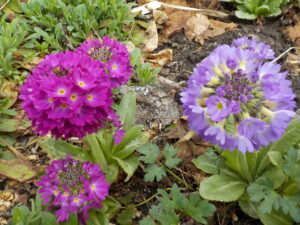
Drumstick primroses
My favorite early spring perennial is called the drumstick primrose (Primula denticulata). It comes with flowers in purple, blue, pink, magenta and white. The florets are small and arranged in 2-to 3-inch globes on 6-inch stems. They do best in moist to wet soil in sun or partial shade.
Hellebores or Lenten Roses (Helleborus orientalis) are also wonderful spring flowers. Mine have been blooming for a couple of weeks already and will continue on for another month or so. The blossoms are 5-petaled and 2- to 3- inches wide with yellow stamens in the center. Colors range from white and cream to pink, purple and nearly black. They are evergreen, but last year’s leaves should be cut off now as they are all bedraggled.
A dainty flower with beautiful finely-cut foliage is a spring ephemeral called corydalis or fumewort (Corydalis solida). It pops up in my garden where it wishes, and I am always glad to welcome it. It seems to do best in moist, part shade with rich soil. The flowers on mine are small, long-spurred light blue, but other colors are also possible. There is a yellow variety of a related species (C. lutea).

Corydalis solida
Lungwort or pulmonaria (Pulmonaria spp.) is a good ground cover that is blooming for me now, too. It is interesting that a single stem might support blue, pink or apricot flowers all at once. All do well in shade or partial shade and better in moist soils than dry soils. It spreads by root.
There are at least a dozen different species of pulmonaria including P. longifolia with spotted leaves and multicolored blossoms. The one I like best is P. angustifolia which has very intense blue flowers and solid green leaves. I’ve read that varieties or species with more white spots grow better in full sun than those with fewer or no spots.
Wildflowers are starting to bloom, including one of my favorites, bloodroot (Sanguinaria canadensis). These white multi-petaled flowers come up from the soil wrapped in the leaves that look like a green cigar. In cold days, or at night, the blossoms close up but open on sunny days when the bumblebees are working.
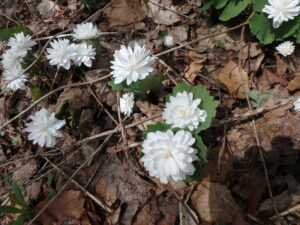
Double bloodroot is rare and not usually found in the wild but is sold in specialty nurseries
The bloom season of bloodroot is short, but there is double bloodroot which is sterile and blooms for a longer time. Like all bloodroots, the clumps get bigger every year, so you can dig them up and divide them to start doubles in new places. The sap from the roots is poisonous, so wear gloves when dividing any bloodroots. Do that in now, or in the fall.
We certainly deserve spring blossoms for having survived winter and mudseason. But you do have to plan and plant for those early bloomers.
Henry is the author of 4
gardening books and is a 25-year veteran of the Master
Gardener program. Reach him by email at
henry.homeyer@comcast.net.
Are you in a rut? Spring is here, but most of us cannot plant anything outdoors due to cold nights or wet ground. Yes, you can plant seeds indoors and baby them until early summer, but that requires a place to grow them and lights to keep them happy. So maybe you should put on your thinking cap and decide what you want to do later on, and do some research.
Or what about the International Aroid Society? The Arum genus has a diverse collection of plants from skunk cabbage to Philodendrons to Colocasia yams. The Plumeria Society of America is focused solely on the 11 species of Plumeria – known as Frangipani in English. Hostas? Wildflowers? Boxwood or Bonsai? There are societies for each and every group.
Any easy project indoors would be to start an avocado tree. Avocados ripen in California starting in spring and going through summer. Winter avocados won’t usually sprout from their seeds – they have been in cold storage too long. The classic method it to perch a seed in a glass of water using 3 toothpicks to keep its bottom just kissing the water. Put the point end up and the fat end down. I cut one open recently, and it was already sprouting! So I planted it in a mixture of potting soil and compost. I let the sprout just peak out above the soil line.
Try to remember the favorite flowers of your grandparents, or your parents. This would be a good time to ask your mom, for example, what did her mom really love? My grandmother, who died in 1953, loved peonies. My mother, may she rest in peace, dug up one of her mom’s peonies and moved it from Spencer, MA to Woodbridge, CT and grew it for decades before I came along and divided it in the early 1980’s and brought a part of it to Cornish Flat, where I live. The peony I got is called ‘Festiva Maxima’ a highly fragrant double white, with splotches of red inside – blood from a fairy princess, I think.
If your Grammy loved roses, study your yard and figure out where one could go in loving memory of her. And do a little research now if you have never grown roses. Roses are easier to grow now than they were 40 or 50 years ago when Grammy was growing them. I love the ‘Knockout” series of roses. The Knockouts are not fragrant, so they do not attract Japanese beetles, and they bloom for months. They are highly resistant to diseases. They don’t have long stems, but sometimes I have dozens of blossoms at once – for months.
Think about planting an oak later in the month. Many gardeners don’t think of planting oaks saying they get too big, or grow too slowly. But it has been proven that oaks are the #1 best plant to support our birds, pollinators and mammals. And you can even plant a sprouting acorn now.
Want a fast-growing flowering tree? Plant a catalpa. They are native and the flowers are amazing. Fragrant, attractive. The leaves are huge – big enough that Native Americans used them for diapers for babies, I’ve read. I bought a 10-footer five years ago and now it already a shade tree – 25 feet tall with a 20-foot wide crown.
What else can you do? Grow a lot of something you love, starting from seed. I love rosemary, and recently bought a packet of seeds and planted 50 seeds. If all goes well, I will have plenty to share.
I will grow them on an electric heat mat (designed for use with seeds) as they germinate best at temperatures in the 70’s. Once they have germinated I will grow them under very bright LED lights, and will transplant them into rows in my vegetable garden in mid-June. Of course I will keep some in pots, and grow them on the deck.
Lastly, plan on growing a vegetable you have never grown before. Me? This is the year of the tomatillo. I did grow one once before, but only one plant and they are not self-pollinating. So this year I plan to plant 3 or 4. They are big plants, as big as tomato plants. You might try tiny decorative pumpkins, or huge ones. Or rutabagas.












